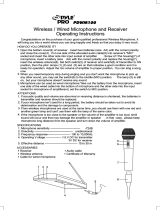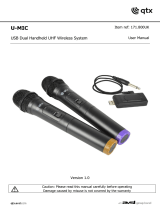
7
BT-8U Bodypack Mic Transmitter
1. Snap open the BATTERY DOOR (13) and
insert a fresh 9V alkaline or NiMH battery
into the BATTERY COMPARTMENT (14)
observing the correct polarity. Close the
battery door to its original position and
completely cover the battery. Fresh alkaline
batteries can last up to 10 hours in use, but
in order to ensure optimum performance,
it is recommended that the battery be
replaced after 6-8 hours of use. A NiMH
battery should be replaced with another
recharged fully (with separate charger,
not supplied, and as per its charging
instructions) whenever low or dead battery
status is indicated as per the following.
2. Selecting Audio Input Operating Mode: The
BT-8U is equipped with two INPUT SELECTOR
SWITCHES (15) located under the cover on
the circuit board for selecting the type of
audio input you will be supplying to the
transmitter. Select from the choice of three
positions: INSTRUMENT (for guitar, bass,
etc.), HEADWORN MIC, and LAVALIER
MIC (Condenser Microphones).
(Note: Use only the input audio source as per the
input selected with the internal AUDIO INPUT
SELECTOR SWITCHES (15) or the audio will
not be optimal–a muddy or distorted sound
may result.)
There are two switches with selectable
positions GT, HM, LT together at the
same time.
To select inputs: (see chart on page 9)
A. Instrument: Set both switches to GT
B. Headworn Mic: Set both switches to HM
C. Lavalier Mic: Set both switches to LT
3. Connecting for Selected Input: The BT-8U
is provided with a 3.5 mm LOCKING JACK
(16) for connecting the audio input selected.
Connect either the INSTRUMENT CORD (17)
or the HEADWORN MIC (18) or LAVALIER MIC
CORD (19) as desired, according to the input
selected. To secure the connection, turn the
slip ring on the plug clock wise to thread it
on the jack. To unplug, reverse the process.
Slip the transmitter into a pocket or CLIP
(20) it on to your clothes or instrument
strap (if using the BT-8U as an instrument
transmitter).
4. Turn on the BT-8U by sliding the OFF/
STANDBY/ON SWITCH (21) to the STANDBY
position (transmitter on, audio muted) or
the ON position (transmitter and audio both
on). The BATTERY INDICATOR LED (22) will
give a single quick flash, indicating usable
battery strength. In the case of a dead or
low battery, the LED either will not go on
at all or will stay on continuously, indicating
that the battery should be replaced with a
fresh one. To conserve battery life, turn unit
off when not in use.
5. The BT-8U transmitter is now ready
to use. The SIGNAL LED (5) on the DKW-
8U receiver should now be lit, indicating
a received signal from the transmitter.
Adjust the volume of the receiver as per the
Connecting the Audio Output of the above
DKW-8U receiver instructions.
6. Instrument Use: Secure the connection
from the GT CABLE (17) by turning the
slip ring on the plug into the transmitter
clockwise to thread it on the jack. To
unplug, reverse the process. Plug the 1/4”
phone plug into the instrument. When
ready to play, slide the audio OFF/STANDBY/
ON SWITCH (21) to either “STANDBY or ON”
position. Adjust the volume of the receiver
as per the Connecting the Audio Output of
the above DKW-8U receiver instructions.
(Note: The INPUT LEVEL CONTROL (23) is deactivated
and not used when the BT-8U is in INSTRUMENT
(GT) mode. Levels should be adjusted with the
volume control of your instrument.)















